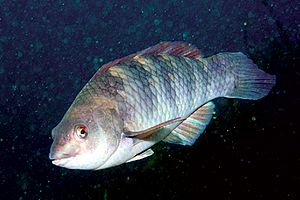Banded parrotfish facts for kids
Quick facts for kids Banded parrotfish |
|
|---|---|
 |
|
| Conservation status | |
| Scientific classification | |
| Synonyms | |
|
The banded parrotfish, also known by many other names like the blue wrasse or kelpie, is a type of fish called a wrasse. You can find it in the eastern Indian Ocean, near eastern Australia, and all around New Zealand. These fish live in rocky areas with lots of seaweed, like kelp forests. Scientists have found that some of these wrasses can live for at least 35 years!
Contents
What Does the Banded Parrotfish Look Like?
The banded parrotfish (Notolabrus fucicola) is the biggest wrasse you'll find in New Zealand waters. In Australia, they can grow up to 45 centimeters (about 18 inches) long. But in New Zealand, they can be even bigger, reaching lengths of 60 centimeters (about 24 inches) and weighing up to 5 kilograms (about 11 pounds).
These fish have a deep body and their colors can change quite a bit. Young adult fish are reddish-brown with patches of green and orange. Older adults are more green-brown with hints of purple and fuzzy yellowish stripes on their bodies and fins. Young fish look similar to young adults but have bright yellow markings.
Where Do Banded Parrotfish Live?
You can find the banded parrotfish in the southeastern Indian Ocean and the southwestern Pacific Ocean. This includes areas around Australia and New Zealand. In New Zealand, they live all over, from the Three Kings Islands in the north to Stewart Island and the Snares Islands in the south.
In Australia, they are found off the southeastern coast. This includes southern New South Wales, Victoria, eastern South Australia, and Tasmania.
Life in the Ocean: Habitat and Diet
Banded parrotfish are generalist predators, meaning they eat many different things. They have strong canine teeth that help them pull chitons, limpets, and barnacles off rocks. They can also crush and eat mollusks, crabs, and sea urchins.
What they eat changes as they grow. Smaller fish, about 10 to 18 centimeters (4 to 7 inches) long, mostly eat tiny creatures like amphipods and isopods. Larger fish prefer bigger meals, mainly eating bivalves (like clams), crabs, and snails.
These fish live in kelp beds and over rocky reefs. They like areas where there's some movement from tides and currents, in waters from 1 to 90 meters (3 to 295 feet) deep. They are also quite territorial fish. This means they defend their own space aggressively from other fish. They can live for a long time, often over 20 years!
Banded parrotfish lay their eggs in the southern spring and summer, from July to December. They don't all lay eggs at the same time. Interestingly, some of these fish can change their sex as they grow, which is a bit unusual for fish. Even though they can change sex, males and females don't look very different from each other.
How Was This Fish Named?
The banded parrotfish was first officially described in 1840. A Scottish naturalist named John Richardson gave it the scientific name Labrus fucicola. He found the first examples of this fish near Port Arthur, Tasmania. Much later, in 1988, another scientist named Barry C. Russell created a new group of fish called Notolabrus, and he made Labrus fucicola the main example for this new group. That's why its full scientific name is Notolabrus fucicola today.
Banded Parrotfish and Humans
The banded parrotfish is a popular fish for both commercial fishermen and people who fish for fun. They are known to sometimes bite divers, which can leave a small scratch.
Off the coasts of Victoria and Tasmania in Australia, commercial fishermen catch these fish using traps and hand-lines. They are often sold as live fish. In Tasmania and eastern South Australia, they are also commonly caught by accident when fishermen are trying to catch lobsters. When this happens, the wrasse is often kept to be used as bait. People who enjoy fishing with rods or spears also like to catch them.
Protecting the Banded Parrotfish
Banded parrotfish are quite easy to catch because they are territorial and compete for food. This means they can be caught from rocks, boats, and piers. In some areas, their numbers have gone down. This is most likely due to too much fishing. Other things like mud settling on their habitats (sedimentation) and pollution from nutrients can also harm their rocky reef homes.
To help protect them, some areas have rules. In Victoria, there's a minimum size limit for how big a fish must be before it can be caught. Also, the number of commercial fishing licenses is limited. In Tasmania, the minimum legal size is 30 centimeters (about 12 inches), and there are 58 fishing licenses issued.
The banded parrotfish also lives in several marine protected areas, which are like underwater parks where fishing might be limited or not allowed. The IUCN, a group that studies how safe species are, says this fish is of "Least Concern" right now. However, they recommend that more research is needed to understand how fishing affects their populations and to track how their numbers are changing over time.
See also
 In Spanish: Notolabrus fucicola para niños
In Spanish: Notolabrus fucicola para niños


